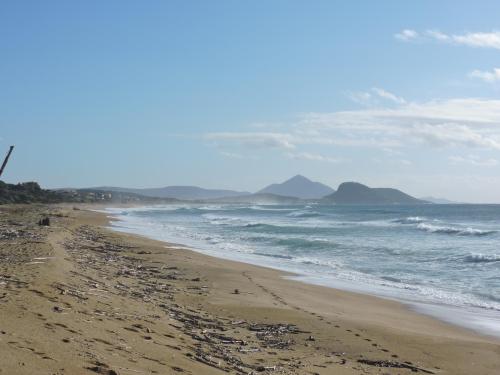The house is one of the first traditional houses built in the 1870's, during the time of naval glory, consisting of three parts, the garden, the ground floor and the upper floor with thick walls, iron or wood on the lower windows and heavy wooden doors. It is the only traditional home of Nafpaktos built literally on the beach with waves in winter reaching a few meters from it. From the Villa’s unique balcony one can enjoy the imposing view of the old Venetian castle , the town and the port, dominated by the cable Rio-Antirrio bridge on the horizon. After the Greek Independence War this house hosted the first primary school of the city. It has a unique view of Nafpaktos and has been characterized as a traditional- historic building from the Greek state.
The house has one central AC unit is located in the living room and the 2 big bedrooms have an independent ceiling fan and not an AC unit. The smallest bedroom has an independent ground fan as well.
Nafpaktos (Lepanto) is a town with a long history. The city holds its name from the words ‘’nafs’’ which means sea and ‘’pignymi’’ which means "shipyard. It first appeared in 1104 BC. with the Dorians, who, on their descent, used Nafpaktos to build rudimentary boats (rafts for accuracy), so Nafpaktos became a heritage. In Greek legend, Nafpaktos is the place where the Heraclidae built a fleet to invade the Peloponnese. Centuries later, specifically on the 7th October of 1571, a great and monumental naval conflict took place between the Ottoman fleet and the united naval forces of Sacra Lega, a sacred alliance formed by the Spanish naval forces, the Pope, Venice and some Italian states. The city is located 218 km away from Athens, 97 km from the archeological site of Delphi , 141 km from Ancient Olympia and 45 km from the ancient theatre of Iniades and the historical city of Mesolongi. Nafpaktos is a place for discerning travelers looking for different forms of alternative tourism. Evinos River and Nafpaktia Mountains create landscapes of unique natural beauty and are ideal for sports activities like rafting, rappel, mountain bike, climbing, horseback riding, hiking and SUP.
The castle, with panoramic views of the city and the Corinthian Gulf, dominates imposingly on the top of the hill with its walls reaching up to the Venetian harbor. To the east and west there are the beaches of Psani and Grimbovo.
Walking through the city's old Venetian Castle and the paved streets, passing through the Tzavela Mansion, the Botsari Museum and the Mosque, where the ruins of the Turkish mosque and the Turkish bath are preserved and the old picturesque harbor (where the "soprano" the old market was located) will make the traveler feel the aura of the golden Venetian era which has left its pieces unchangeable through time. At the eastern tower there is the old lighthouse and the Fethiye Tzami (mosque) of 1499. The built-in marble plaque reminds us of the famous sea battle of 1571. At the western part and next to the cannons targeting the sea, there are the statues of the legendary captain Giorgos Anemogiannis and of the famous Spanish writer Miguel de Cervantes (who fought in the battleship of Nafpaktos).
Today, the area embracing the old harbor (Stenopazaro) is the heart of the night life of the city where many cafes, bars and greek taverns are located.
Languages spoken: German,Greek,English,Spanish


